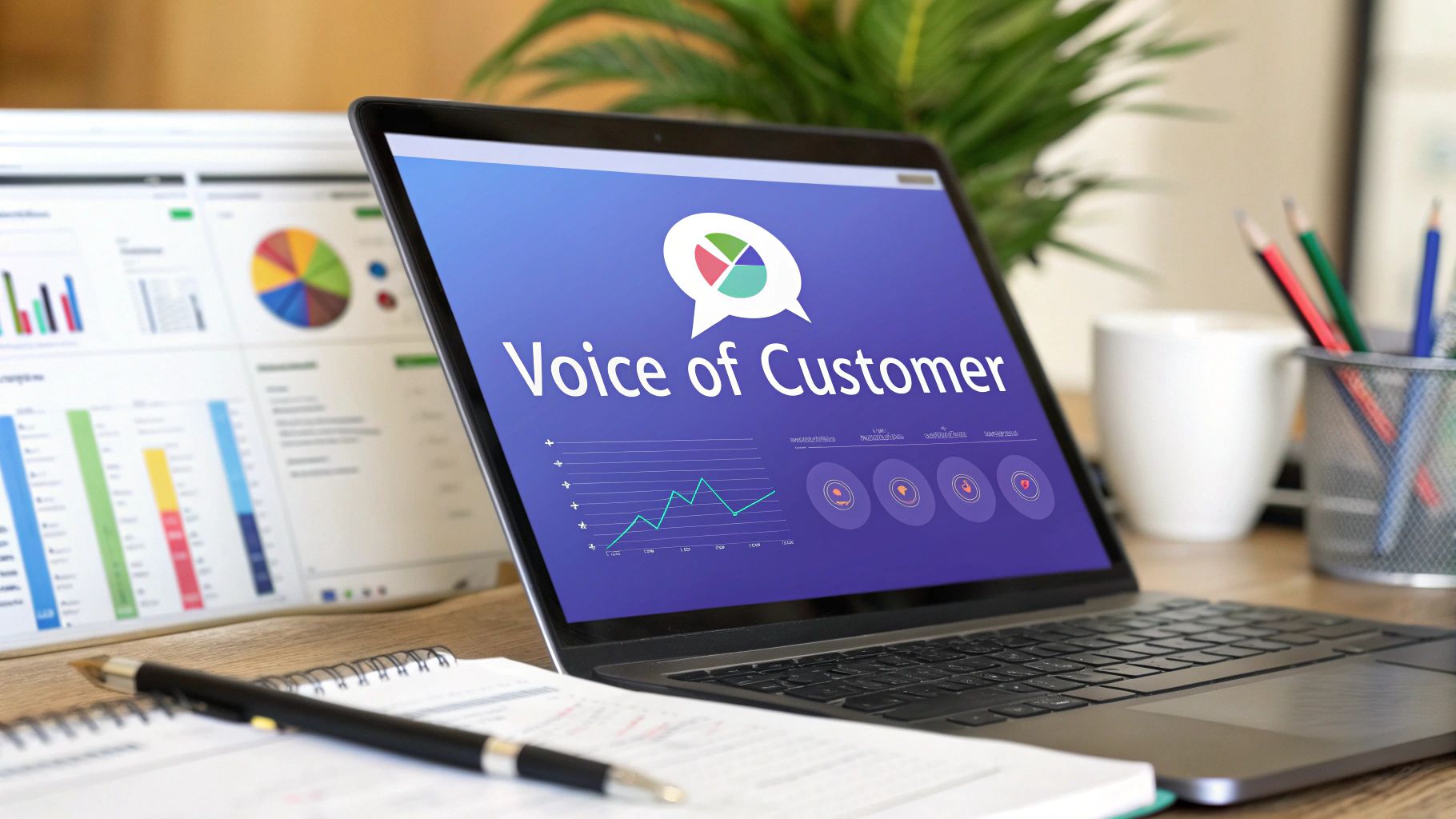Optimizing Customer Experience for SaaS Growth
A practical guide to optimizing customer experience in SaaS. Learn proven methods for collecting feedback, mapping user journeys, and increasing retention.

Optimizing the customer experience is a systematic process of figuring out how people interact with your software at every stage and then making it better. It means using real feedback to make your product more intuitive, valuable, and enjoyable to use.
For any SaaS company, this is the secret to reducing churn and building a loyal following that sticks around.
What Is Customer Experience Optimization in SaaS?

At its core, optimizing the customer experience is the ongoing work of improving every interaction someone has with your product and brand. This goes beyond fixing bugs or adding features based on a gut feeling. We're talking about building a structured system to collect, analyze, and act on user feedback.
This data-driven approach lets you make smart, informed decisions that improve customer satisfaction and drive real growth. Instead of shipping random updates and hoping for the best, you build a clear roadmap for improvements based on what your users want and need.
The Business Impact of a Better Experience
Let's be clear: a sharp focus on the customer experience directly hits your bottom line. It's that simple. Happy customers are far more likely to stick around, which means less churn and a higher lifetime value. Even better, they become your best advocates, driving word-of-mouth referrals that bring in new business without you spending a dime on ads.
The data backs this up. A recent study found that 70% of customers now pick brands based on their expectation of a great experience. It also highlighted that emotional drivers, like feeling like they're being treated fairly, are key to building strong relationships.
It's pretty obvious that investing in a great experience is a core business strategy.
Building a Foundation for Growth
When you formalize your customer experience program, you create a repeatable process for constant improvement. It helps you shift from being reactive (putting out fires) to being proactive, solving issues before they become a source of frustration for your users. This system is the bedrock for sustainable growth, especially in a crowded market.
For a SaaS company, this usually involves a few key things:
- Mapping the User Journey: You need to map out every touchpoint, from the moment a user signs up to their daily interactions with your tool.
- Listening to Feedback: This means actively gathering insights, whether through in-app surveys, user interviews, or support tickets.
- Closing the Loop: The most important step. You have to act on the feedback and then let your users know they've been heard. It shows you're listening and that their opinion matters.
If you're looking to find practical strategies you can implement right away, check out these proven ways to improve customer experience.
How to Gather Actionable Customer Feedback
If you want to start making real improvements to your customer experience, you have to stop guessing. Guesswork leads to building features nobody asked for and fixing problems that aren't the real problems. The only way forward is to build a system for collecting feedback that gives you a crystal-clear picture of what people are thinking and doing inside your product.
The goal here is not a one-off survey. It's about creating a constant stream of information that tells you both what is happening (the numbers) and why it's happening (the stories). Mixing a few different feedback methods is the key to getting a perspective you can trust.
Combining Different Feedback Methods
Relying on just one feedback channel is a recipe for a skewed view of reality. For example, a low Net Promoter Score (NPS) is a giant red flag, but it only tells you that users are unhappy, not why. To get the full story, you need to combine different approaches.
Here are a few of the most effective methods I've seen work time and time again:
- Targeted In-App Surveys: Tools like NPS or Customer Satisfaction (CSAT) surveys are perfect for getting a quick pulse on how users feel at important moments. You can trigger them right after someone finishes onboarding or uses a new feature for the first time.
- One-on-One User Interviews: Nothing beats talking to your customers. These conversations are where you uncover qualitative insights into their real-world frustrations, goals, and "aha!" moments. This is how you find the context behind the data.
- Session Replay Tools: Think of these as a DVR for your user sessions. Tools like Hotjar or FullStory let you watch recordings of real users interacting with your product. It’s like looking over their shoulder to see exactly where they get stuck, hesitate, or rage-click. You'll spot friction points you would never find otherwise.
This simple visual breaks down how different touchpoints align with the stages of a customer's journey.

Knowing these stages helps you strategically place your feedback mechanisms where they'll have the biggest impact.
Picking the right tool for the job is half the battle. Each feedback method has its own strengths and weaknesses.
Customer Feedback Collection Methods
Ultimately, a mix of these methods will give you the most complete and reliable picture of your customer experience.
Asking the Right Questions
The quality of the feedback you get is directly tied to the quality of the questions you ask. Vague questions will always get you vague, useless answers.
Instead of asking something generic like, "Do you like our new feature?" you need to reframe it to dig into specific behaviors and intentions.
A much better question is, "What was the main reason you decided to try our new reporting feature today?" This kind of open-ended question encourages a detailed story that reveals the user’s true motivation.
Learning to ask better questions is a skill that pays dividends. For anyone looking to level up, exploring various survey questions examples is a great place to start. It gives you a solid foundation for crafting queries that get you actionable answers.
This approach helps you move beyond simple "yes/no" responses and find out what your best users want and what’s causing friction for everyone else. These are the insights that become the raw material for genuine product improvements.
Mapping Your SaaS Customer Journey

A great customer experience is built on the sum of every interaction a user has with your product, from their first curious click on your website to the day they can’t imagine their workflow without you. If you want to optimize that experience, you have to see your product through their eyes.
This is where a customer journey map comes in. Think of it as a strategic blueprint that visually lays out every stage of your customer's relationship with your SaaS. It’s a powerful way to move beyond assumptions and see where your experience is shining and where it’s causing hidden frustration.
Identifying the Key Stages of the Journey
For any SaaS product, the customer journey is rarely a straight line, but it generally follows a few predictable stages. Mapping these out is your first step to seeing the complete picture and identifying the major milestones that define the user lifecycle.
Your map will likely include stages like these:
- Awareness: The very beginning. This is where a potential customer first learns your product exists, whether through a blog post, a social media ad, or a recommendation.
- Sign-up: The moment they decide to give you a shot, whether it’s a free trial or a paid plan. This is your first real chance to make a good impression.
- Onboarding: This phase is very important. It's where you guide new users to their first "aha!" moment. A smooth onboarding process dramatically increases the odds they’ll stick around.
- Feature Adoption: As users get more comfortable, this stage is about how they discover and start using more advanced features, unlocking more value from your tool.
- Renewal & Advocacy: This is the goal. Your user is happy, renews their subscription, and starts telling friends and colleagues about your amazing product.
If you need a hand organizing this process, our guide on using a customer journey mapping template offers a great starting point for structuring your own map.
Pinpointing Actions, Motivations, and Frustrations
Once you have your stages defined, the real work begins. For each one, you need to dig into the details from the customer’s perspective. This is where you connect all that feedback data you've been collecting to the real-world experience of using your product.
The most valuable journey maps don’t just list actions; they uncover the emotions behind them. What was the user trying to accomplish? What made them feel successful? What roadblock almost made them give up?
Let's take the Onboarding stage, for example. You might find that users are completing your setup checklist (the action) but are still totally confused about what to do next (the frustration). Their motivation was to solve a specific problem quickly, but it turns out your UI wasn’t as intuitive as you thought.
These insights are gold. They show you exactly where a small tweak could prevent a new user from churning before they even get started. A well-researched journey map turns abstract feedback into a clear, actionable roadmap for making your product better.
Turning Customer Insights into Real Product Improvements
Collecting feedback through surveys and journey maps is a solid first step. But let's be honest, that data is pretty useless until you do something with it. The real magic happens when you translate those insights into tangible, meaningful changes in your product. This is where you shift from just listening to actively improving the user experience.
The biggest hurdle? Figuring out what to tackle first. Your feedback channels will probably light up with a long list of bug reports, feature requests, and usability complaints. You can't do it all at once, which is why you need a simple, effective way to prioritize.
A Simple Framework for Prioritization
A good prioritization framework helps you make objective decisions instead of just reacting to the loudest voice in the room. It’s about moving away from guesswork and toward a system that weighs effort against impact. A popular and refreshingly straightforward method for this is the RICE scoring model.
RICE is an acronym that stands for:
- Reach: How many users will this improvement affect over a specific time period? (e.g., 500 users per month)
- Impact: How much will this matter to an individual user? (Use a simple scale: 3 for massive impact, 2 for high, 1 for medium, 0.5 for low)
- Confidence: How sure are you about your estimates for reach and impact? (e.g., 100% for high confidence, 80% for medium, 50% for low)
- Effort: How much time will this take from your team? (Estimate in person-months or weeks)
You then run a quick calculation to get your score: (Reach x Impact x Confidence) / Effort. The higher the score, the higher it goes on your to-do list.
This simple formula forces you to think critically about every potential project. A small bug fix that impacts every single user might score higher than a cool new feature requested by a handful of power users. It gives you a data-informed way to build your product roadmap.
Don't Forget to Close the Loop
Once you've prioritized and shipped an improvement, your job isn't quite done. The final, and arguably most important, step is to close the feedback loop. This is just a fancy way of saying you need to let your customers know you heard them, valued their input, and took action.
This is the step that turns casual customers into loyal advocates. When users see their suggestions lead to real product changes, they feel like they’re a valued partner in your journey. That kind of goodwill and trust is priceless.
Here are a few easy ways to do this:
- Personalized Emails: Shoot a direct email to the specific users who requested a feature or reported a bug once it's fixed. It’s a small touch that has a huge impact.
- In-App Notifications: Announce new features and improvements with a notification right inside your product.
- Public Changelog: Keep a public log of all your updates so everyone can see the progress you're making.
Ignoring feedback is one of the fastest ways to lose customers. A 2025 analysis found that 21% of brands saw their CX rankings drop, even after pouring more money into it. This often happens when there's a major disconnect between listening and acting.
And considering loyal customers are up to five times more likely to buy from you again, closing that feedback loop is a core part of a healthy, growing business. You can find more on this trend by checking out these customer experience statistics for 2025.
Moving to Proactive Customer Support

A truly standout customer experience is about more than just putting out fires as they pop up. It’s about getting ahead of them. This is the whole idea behind shifting from reactive to proactive support, solving issues before your customers even know they need help.
This single shift can transform your support team from a cost center into a powerful engine for customer retention. You’re showing users that you’re actively invested in their success, not just sitting around waiting for them to file a ticket when something breaks.
Using Data to Anticipate Needs
The secret to proactive support is knowing what your users are doing inside your product. By analyzing how people interact with your software, you can spot the early warning signs of frustration.
Think about it: if someone is clicking around the same settings page for an unusual amount of time, they’re probably stuck.
Instead of waiting for them to give up and fire off an angry email, you can jump in. A simple, automated chat message offering help or a link to a relevant guide can make all the difference. That small gesture can head off a support ticket and turn a moment of friction into a genuinely positive interaction.
You can monitor a few common behavioral patterns:
- Time on page: If a user is spending way too much time on a specific feature or settings page, they might be confused.
- Repetitive actions: Clicking the same button over and over or navigating back and forth between two screens is a classic sign of trouble.
- Feature neglect: When a user has never touched a key feature, they might need a gentle nudge to discover its value.
How Automation Can Help
Let’s be real, it’s impossible to manually watch every single user. This is where automation and AI become your best friends for optimizing customer experience at scale. Modern tools can monitor user behavior in the background and trigger helpful interventions automatically.
By setting up rules based on specific user actions (or inactions), you can deliver the right help at the exact moment it's needed. This turns your support system into an intelligent, proactive assistant that guides users toward success.
This trend is moving fast, going beyond basic personalization into what’s known as hyper-personalization. The latest research shows that companies using AI can now predict customer issues with up to 85% accuracy in some industries, letting them solve problems before they even happen. This proactive approach is quickly becoming the new standard. You can read more about these customer experience trends from IBM.
Measuring the Impact of Your CX Program
You've mapped out the entire customer journey, gathered a ton of feedback, and started turning those insights into actual product improvements. That's great, but how do you know if any of it is working?
The only way to prove the value of all that hard work is to connect it back to real, tangible business results. Measuring your program's impact is about demonstrating a clear return on investment.
This means you have to look past the vanity metrics and zero in on the key performance indicators that show the health of your customer relationships. When you track these numbers over time, you can draw a straight line from a product update or a process change to a positive shift in how customers behave.
Key Metrics for SaaS CX Success
For any SaaS business, a handful of specific metrics tell a powerful story about your customer experience. They give you a clear, numbers-based view of whether your improvements are making a difference where it counts.
Here are the essentials you need to keep a close eye on:
- Net Promoter Score (NPS): The classic. NPS measures customer loyalty by asking one simple question: how likely are they to recommend you? It’s a fantastic high-level indicator of overall customer sentiment.
- Customer Satisfaction (CSAT): This one is usually measured right after a specific interaction, like closing a support ticket. CSAT gives you immediate, targeted feedback on the quality of individual touchpoints in your customer journey.
- Churn Rate: This is the big one for SaaS. Churn is the percentage of customers who cancel their subscriptions in a given period. A dropping churn rate is one of the strongest signals you can get that your customer experience is on the right track.
- Customer Lifetime Value (CLV): CLV predicts the total revenue you can expect from a single customer over their entire relationship with your company. When CLV starts climbing, it means customers are sticking around longer and becoming more valuable to your business.
To give you a clearer picture, here's a quick breakdown of these metrics and why they're so important for SaaS.
Key CX Metrics for SaaS
Tracking these metrics is not just about reporting; it's about creating a powerful feedback loop.
Imagine your product team ships a new feature designed to reduce friction in your onboarding flow. The next month, you see CSAT scores for that specific workflow jump, and churn rates for new cohorts dip slightly. You’ve just proven the ROI of your work.
To really get a handle on your performance, a review of SaaS customer success metrics can provide some extra context and nuance.
Making that direct connection between action and outcome is what separates a good CX program from a great one. You can learn more about how to track these numbers effectively by exploring these core customer success metrics in more detail. It’s how you justify future investment and build a culture that puts the user first.
A Few Lingering Questions on SaaS CX Optimization
As SaaS teams start getting serious about customer experience, a few questions almost always pop up. Let's tackle some of the most common ones to help you get your strategy straight from the get-go.
How Often Should We Be Collecting Feedback?
Honestly, this needs to be an ongoing thing. Think of it as a blend of continuous and periodic check-ins.
You’ll want some methods running all the time, like in-app NPS surveys that pop up after a user completes a key action. At the same time, you should schedule more in-depth efforts, like quarterly user interviews, to dig deeper. The idea is to always have a fresh pulse on how your users are feeling.
What’s the Single Biggest Mistake to Avoid?
This one’s easy: collecting a mountain of feedback and then letting it gather dust.
Doing nothing is worse than not asking for feedback at all. It sends a clear message to your customers that their opinions don't matter, which kills trust fast. You must have a system in place to analyze, prioritize, and act on the insights you gather.
Which Team Should Really Own This Initiative?
This is a trick question. While you might have a project lead or a CX manager steering the ship, customer experience is ultimately everyone's job.
For this to work, it has to be a collaborative effort. Product, marketing, sales, and support all have a stake in the game and bring a unique perspective. The insights you collect are gold, and every one of those teams needs access to them to do their best work.
Ready to turn all that customer feedback into actual, measurable growth? Surva.ai gives you the tools to finally understand your users, slash churn, and build a product they can't stop talking about. Start optimizing your customer experience today.


